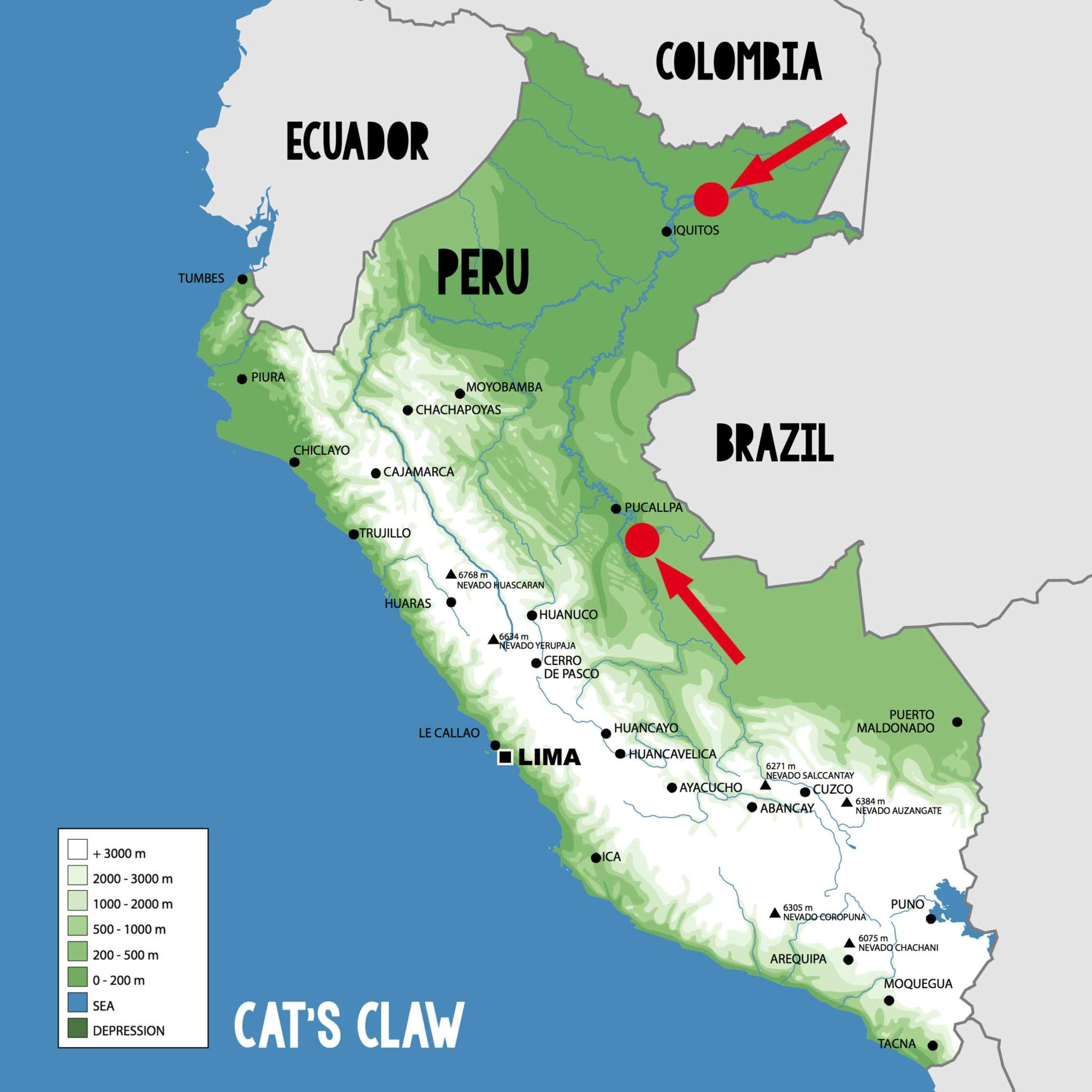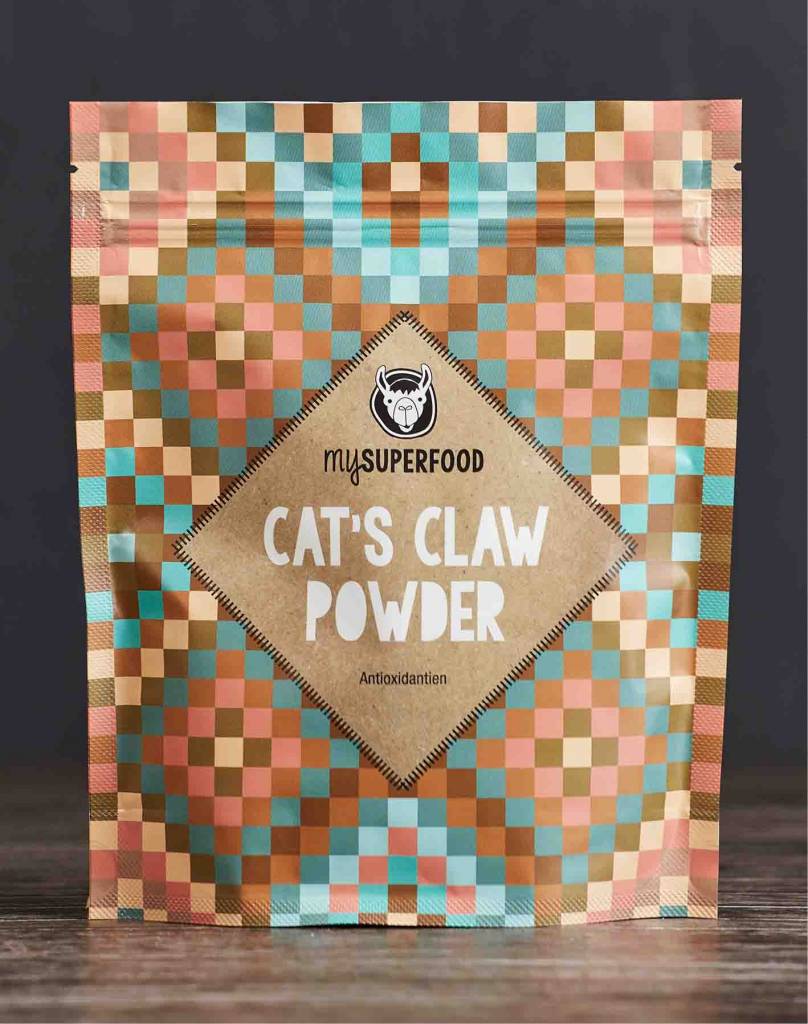
Cat's Claw Powder, 100 g
Price: 13,90 CHF
- Article number
- 00007
- Availability:
- Out of stock
- Delivery time:
- Unit price:
- CHF 13,90 / 100 Gram
Cat’s Claw – the wonder herb growing in the Peruvian rain forest. The natives have used this product for centuries as a special healing substance. Cat’s Claw helps numerous complaints, has a detoxing quality for the body and strengthens the body’s d...
##Infos##
-Typ: Antioxidants -
-Net weight: 100 g -
-Ingredients: 100% Cat’s Claw Powder / Wild crop -
-Origin: Peru -
##
##Nährwerte##
| Nutritional Value | per 100 g | per Portion (4 g) | ||
| Energy | 370 kcal | 14,8 kcal | ||
| (1550 kJ) | (62 kJ) | |||
| Fat | 0,4 g | < 0,1 g | ||
| thereof saturated fatty acids | 0 g | 0 g | ||
| Carbohydrates | 89 g | 3,56 g | ||
| thereof sugar | 0 g | 0 g | ||
| Protein | 2 g | 0,08 g | ||
| Salt | < 0,1 g | < 0,1 g | ||
| All information subject to the usual fluctuations in natural products | ||||
##
##Beschreibung##
Cat’s Claw – the wonder herb growing in the Peruvian rain forest.
The natives have used this product for centuries as a special healing substance. Cat’s Claw helps numerous complaints, has a detoxing quality for the body and strengthens the body’s defences and immune system.
Due to its special natural healing properties Cat’s Claw is particularly used as a tea or in smoothies.
We buy our Cat's Claw direct from producer in Peru: it is being collected from local people in the peruvian Amazon / region Loreto and afterwards processed very gently.
##
##Inhaltstoffe##
Ingredients
The Latin name of Cat’s Claw or “Uña de Gato“ is “Uncaria tomentosa“.
Already the indigenous people of the Amazon region used the root and bark of this thorny liana plant to strengthen their immune system and heal wounds.
The ingredients found in the inner bark of Cat’s Claw (amongst others alkaloids, antioxidants such as polyphenol, triterpene, flavonoid such as epicatechin and procyanide, sterole (especially beta-sitosterin), terpenoid, and ursolic acid derivative) help to build new and healthy cells. They are said to help with stomach and digestive problems, with allergies such as asthma and with rheumatism and cancer, due to its anti-viral, inflammatory, antioxidant, immune boosting, and anti-leukemic functions.
Different studies discovered this impact, especially that oxindolalkaloids found in Cat’s Claw have an immunostimulating effect. They strengthen white blood cells and in this way help with immune defense.
According to a study at the University of Mailand, Cat’s Claw tea is supposed to ease the side effects of chemotherapy. For example, the ingredients of Cat’s Claw make sure that medication remnants are easier to expel from the body.
The many health benefits of Cat’s Claw have been studied in numerous scientific research studies since their discovery, and individual ingredients have been patented for use in certain medications that, for example, support the immune system.
Benefits
- Strengthens the immune system
- Anti-inflammatory, anti-viral, antioxidant
- Blood purifying and detoxing
##
##Ursprung##
Origin
Our Cat’s Claw is collected by natives in the rainforest of the Peruvian Amazon region near Iquitos (region of Loreto) and near Pucallpa.
Harvest


##
##Verarbeitung##
Processing
Cat’s claw grows wild in the Peruvian Amazon region. It snakes around trees like vine and can be up to 100 meters long. The branches have a diameter of over 30 cm. Cat’s Claw is named for its thorns, which have the shape of the claws of a cat. Indigenous people call it Uña de Gato.
Harvest occurs year round: natives use their machetes to cut off 20x20 cm big pieces from the root bark of Cat’s Claw shrub. They are very careful not to damage or hurt the plant too much. The pieces are gently dried and then processed into a powder.
##
##Verwendung##
Use
Cat’s Claw unfolds the full effect of its powder in tea or in smoothies.
Different recipe ideas can be found on our Recipe page
Dosage recommendation:
Prepare cat’s claw as tea or mix into liquids 1 - 2 x daily 1 teaspoon (4 - 5 g).
Do not exceed the recommended daily amount. This product is not a replacement for a balanced and varied diet. By uncertainty please consult a specialist about the use of this product. Please keep out of the reach of children. Not suited for children under 3 years of age, pregnant or nursing women.
##
##GoodToKnow##
Good to know
An Austrian expedition in the Andes in 1959 coincidentally met a native tribe in the Peruvian Amazon region. A paramedic from Tirol, Klaus Keplinger, asked indigenous healers about the medical plants, and was able to gain knowledge about a plant that was supposed to help with a variety of diseases. It took until 1974 to find out what this plant was, and Cat’s Claw has been the subject of medical research ever since, with astonishing results.
The plant that had been shrouded in mystery belonged to the Rubiaceae family and is now used as a substance in many medications. The plant prefers damp, shady soil in the rainforest, grows to be up to 30 cm thick and 100 m long. The shorter shoots have sickle-shaped thorns in the leave axis that resemble the claws of a cat – leading to the name, Cat’s Claw.
##





